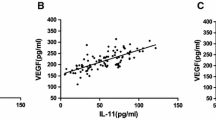Abstract
Iron plays a detrimental role in the intracerebral hemorrhage (ICH)-induced brain damage, while hepcidin is the most important iron-regulated hormone. Here, we investigate the association between serum hepcidin and serum iron, outcome in patients with ICH. Serum samples of 81 cases with ICH were obtained on consecutive days to detect the levels of hepcidin, iron, interleukin-6 (IL-6) and tumor necrosis factor-α (TNF-α). The National Institutes of Health Stroke Scale score (NIHSS) was measured at admission and on days 7 and 30, and the modified Rankin Scale (mRS) score was evaluated at 3 months after ICH. Additionally, the correlations of serum hepcidin with serum iron and the mRS score were analyzed by a generalized linear model. Higher serum hepcidin levels were detected in patients with poor outcomes (P < 0.001), and the mRS score increased by a mean of 1.135 points (95 % CI 1.021–1.247, P < 0.001) for every serum hepcidin quartile after adjusting for other prognostic variables. Pearson correlation analysis showed that serum hepcidin was negatively correlated with serum iron (r = −0.5301, P < 0.001), and a significantly lower concentration of serum iron was found in patients with poor outcomes (P = 0.007). Additionally, serum hepcidin was independently correlated with mRS scores of ICH patients (OR 1.115, 95 % CI 0.995–1.249, P = 0.021). Our results suggest that serum hepcidin is closely related to the outcome of patients with ICH and may be a biological marker for outcome prediction.


Similar content being viewed by others
References
Keep RF, Hua Y, Xi G (2012) Intracerebral haemorrhage: mechanisms of injury and therapeutic targets. Lancet Neurol 11:720–731
Xiong XY, Wang J, Qian ZM, Yang QW (2014) Iron and intracerebral hemorrhage: from mechanism to translation. Transl Stroke Res 5:429–441
Kehrer JP (2000) The Haber-Weiss reaction and mechanisms of toxicity. Toxicology 149:43–50
Gu Y, Hua Y, He Y, Wang L, Hu H, Keep RF et al (2011) Iron accumulation and DNA damage in a pig model of intracerebral hemorrhage. Acta Neurochir Suppl 111:123–128
Nakamura T, Keep RF, Hua Y, Hoff JT, Xi G (2005) Oxidative DNA injury after experimental intracerebral hemorrhage. Brain Res 1039:30–36
Gu Y, Hua Y, Keep RF, Morgenstern LB, Xi G (2009) Deferoxamine reduces intracerebral hematoma-induced iron accumulation and neuronal death in piglets. Stroke 40:2241–2243
Nakamura T, Keep RF, Hua Y, Schallert T, Hoff JT, Xi G (2004) Deferoxamine-induced attenuation of brain edema and neurological deficits in a rat model of intracerebral hemorrhage. J Neurosurg 100:672–678
Auriat AM, Silasi G, Wei Z, Paquette R, Paterson P, Nichol H et al (2012) Ferric iron chelation lowers brain iron levels after intracerebral hemorrhage in rats but does not improve outcome. Exp Neurol 234:136–143
Zhao F, Hua Y, He Y, Keep RF, Xi G (2011) Minocycline-induced attenuation of iron overload and brain injury after experimental intracerebral hemorrhage. Stroke 42:3587–3593
Xi G, Strahle J, Hua Y, Keep RF (2014) Progress in translational research on intracerebral hemorrhage: is there an end in sight? Prog Neurobiol 115:45–63
Wu J, Hua Y, Keep RF, Nakamura T, Hoff JT, Xi G (2003) Iron and iron-handling proteins in the brain after intracerebral hemorrhage. Stroke 34:2964–2969
Zhao N, Zhang AS, Enns CA (2013) Iron regulation by hepcidin. J Clin Invest 123:2337–2343
Ganz T, Nemeth E (2012) Hepcidin and iron homeostasis. BBA-Mo Cell Res 1823:1434–1443
Nemeth E, Tuttle MS, Powelson J, Vaughn MB, Donovan A, Ward DM et al (2004) Hepcidin regulates cellular iron efflux by binding to ferroportin and inducing its internalization. Science 306:2090–2093
Mecklenburg I, Reznik D, Fasler-Kan E, Drewe J, Beglinger C, Hruz P (2014) Serum hepcidin concentrations correlate with ferritin in patients with inflammatory bowel disease. J Crohns Colitis 8:1392–1397
Mehdiratta M, Kumar S, Hackney D, Schlaug G, Selim M (2008) Association between serum ferritin level and perihematoma edema volume in patients with spontaneous intracerebral hemorrhage. Stroke 39:1165–1170
de la Ossa NP, Sobrino T, Silva Y, Blanco M, Millán M, Gomis M et al (2010) Iron-related brain damage in patients with intracerebral hemorrhage. Stroke 41:810–813
Steiner T, Kaste M, Katse M, Forsting M, Mendelow D, Kwiecinski H et al (2005) Recommendations for the management of intracranial haemorrhage-part I: spontaneous intracerebral haemorrhage. Cerebrovasc Dis (Basel, Switz) 22:294–316
Zhou Y, Xiong KL, Lin S, Zhong Q, Lu FL, Liang H et al (2010) Elevation of high-mobility group protein box-1 in serum correlates with severity of acute intracerebral hemorrhage. Mediat Inflamm 2010:2010
Fang H, Chen J, Lin S, Wang P, Wang Y, Xiong X et al (2014) CD36-mediated hematoma absorption following intracerebral hemorrhage: negative regulation by TLR4 signaling. J Immunol 192:5984–5992
Kothari RU, Brott T, Broderick JP, Barsan WG, Sauerbeck LR, Zuccarello M et al (1996) The ABCs of measuring intracerebral hemorrhage volumes. Stroke 27:1304–1305
Urrutia P, Aguirre P, Esparza A, Tapia V, Mena NP, Arredondo M et al (2013) Inflammation alters the expression of DMT1, FPN1 and hepcidin, and it causes iron accumulation in central nervous system cells. J Neurochem 126:541–549
Thomas C, Kobold U, Balan S, Roeddiger R, Thomas L (2011) Serum hepcidin-25 may replace the ferritin index in the Thomas plot in assessing iron status in anemic patients. Int J Lab Hematol 33:187–193
Acknowledgments
This work was supported by grants from the National Natural Science Foundation of China (81271283, 81471191) and the National Basic Research Program of China (973 Program) (2014CB541605).
Conflict of interest
The authors declare no conflict of interest.
Author information
Authors and Affiliations
Corresponding author
Additional information
X.-Y. Xiong and J. Chen contributed equally to this work.
Rights and permissions
About this article
Cite this article
Xiong, XY., Chen, J., Zhu, WY. et al. Serum hepcidin concentrations correlate with serum iron level and outcome in patients with intracerebral hemorrhage. Neurol Sci 36, 1843–1849 (2015). https://doi.org/10.1007/s10072-015-2266-2
Received:
Accepted:
Published:
Issue Date:
DOI: https://doi.org/10.1007/s10072-015-2266-2




